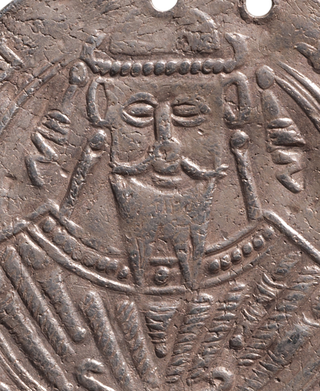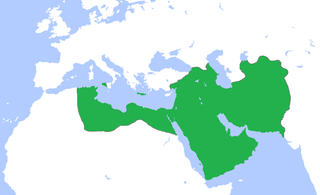Related Research Articles
Ahmad ibn Fadlan ibn al-Abbas al-Baghdadi was a 10th-century traveler from Baghdad,Abbasid Caliphate,famous for his account of his travels as a member of an embassy of the Abbasid caliph,al-Muqtadir of Baghdad,to the king of the Volga Bulgars,known as his risāla.

AbūIsḥāq Muḥammad ibn Hārūn al-Rashīd,better known by his regnal name al-Muʿtaṣim biʾllāh,was the eighth Abbasid caliph,ruling from 833 until his death in 842. A younger son of Caliph Harun al-Rashid,he rose to prominence through his formation of a private army composed predominantly of Turkic slave-soldiers. This proved useful to his half-brother,Caliph al-Ma'mun,who employed al-Mu'tasim and his Turkish guard to counterbalance other powerful interest groups in the state,as well as employing them in campaigns against rebels and the Byzantine Empire. When al-Ma'mun died unexpectedly on campaign in August 833,al-Mu'tasim was thus well placed to succeed him,overriding the claims of al-Ma'mun's son al-Abbas.

Ja'far ibn Muḥammad ibn Hārūn al-Mutawakkil ʿalāAllāh;March 822 –11 December 861,commonly known by his regnal name al-Mutawwakil ala Allah,was the tenth Abbasid caliph,ruling from 847 until his assassination in 861. He succeeded his brother,al-Wathiq,and is known for expanding the empire to its maximum extent. He was deeply religious,and is remembered for discarding the Muʿtazila,ending the Mihna,and releasing Ahmad ibn Hanbal. He is also known for his tough rule,especially with respect to non-Muslim subjects.

Abu’l-ʿAbbās Aḥmad ibn Jaʿfar ibn Muḥammad ibn Hārūn al-Muʿtamid ʿalā’Llāh,better known by his regnal name al-Muʿtamid ʿalā’llāh,was the caliph of the Abbasid Caliphate from 870 to 892. His reign marks the end of the "Anarchy at Samarra" and the start of the Abbasid restoration,but he was largely a ruler in name only. Power was held by his brother al-Muwaffaq,who held the loyalty of the military. Al-Mu'tamid's authority was circumscribed further after a failed attempt to flee to the domains controlled by Ahmad ibn Tulun in late 882,and he was placed under house arrest by his brother. In 891,when al-Muwaffaq died,loyalists attempted to restore power to the Caliph,but were quickly overcome by al-Muwaffaq's son al-Mu'tadid,who assumed his father's powers. When al-Mu'tamid died in 892,al-Mu'tadid succeeded him as caliph.

Abūal-ʿAbbās Aḥmad ibn Ṭalḥa ibn Jaʿfar ibn Muḥammad ibn Hārūn Al-Muʿtaḍid bi'Llāh,853/4 or 860/1 –5 April 902,better known by his regnal name al-Muʿtaḍid bi-llāh,was the caliph of the Abbasid Caliphate from 892 until his death in 902.

Abu'l-Abbas Ahmad ibn Ishaq,better known by his regnal name al-Qadir,was the Abbasid caliph in Baghdad from 991 to 1031.

The Tulunids,were a Mamluk dynasty of Turkic origin who were the first independent dynasty to rule Egypt,as well as much of Syria,since the Ptolemaic dynasty. They were independent from 868,when they broke away from the central authority of the Abbasid Caliphate,to 905,when the Abbasids restored the Tulunid domains to their control.

Osrušana or Ustrushana was a former Iranian region in Transoxiana,home to the Principality of Ushrusana,an important pre-Islamic polity of Central Asia. Oshrusana lay to the south of the great,southernmost bend of the Syr Darya and extended roughly from Samarkand to Khujand. The capital city of Oshrusana was Bunjikat. The exact form of the Iranian name Osrušana is not clear from the sources,but the forms given in Hudud al-'alam,indicate an original *Sorušna.
Abu Ahmad Ṭalḥa ibn Jaʿfar ibn Muḥammad ibn Hārūn al-Muwaffaq bi'Llah,better known by his laqab as Al-Muwaffaq Billah,was an Abbasid prince and military leader,who acted as the de facto regent of the Abbasid Caliphate for most of the reign of his brother,Caliph al-Mu'tamid. His stabilization of the internal political scene after the decade-long "Anarchy at Samarra",his successful defence of Iraq against the Saffarids and the suppression of the Zanj Rebellion restored a measure of the Caliphate's former power and began a period of recovery,which culminated in the reign of al-Muwaffaq's own son,the Caliph al-Mu'tadid.
The Dulafid or Dolafid dynasty was an Arab dynasty that served as governors of Jibal for the Abbasid caliphs in the 9th century. During the weakening of the authority of the caliphs after 861,their rule in Jibal became increasingly independent of the central government in Samarra. In the last decade of the 9th century,however,they were defeated by the Abbasids who proceeded to reincorporate Jibal into their empire.

The Anarchy at Samarra was a period of extreme internal instability from 861 to 870 in the history of the Abbasid Caliphate,marked by the violent succession of four caliphs,who became puppets in the hands of powerful rival military groups.
The Ushrusaniyya were a regiment in the regular army of the Abbasid Caliphate. Formed in the early ninth century A.D.,the unit consisted of soldiers who were originally from the region of Ushrusana in Transoxiana. The Ushrusaniyya initially served under the prominent general al-Afshin,but they remained active after his downfall,and are frequently mentioned during the period known as the Anarchy at Samarra.
Kawus ibn Kharakhuruh was the ruler of the Principality of Ushrusana during the 9th-century. He was the son and successor of Kharakhuruh.

The Principality of Ushrusana was a local dynasty ruling the Ushrusana region,in the northern area of modern Tajikistan,from an unknown date to 892 CE. Ushrusana,just like Ferghana,did not belong to Sogdia proper,but its inhabitants wrote in Sogdian,and may have spoken the Sogdian language as well. The rulers of the principality were known by their title of Afshin.

The Abbasid dynasty or Abbasids were an Arab dynasty that ruled the Abbasid Caliphate between 750 and 1258. They were from the Qurayshi Hashimid clan of Banu Abbas,descended from Abbas ibn Abd al-Muttalib. The Abbasid Caliphate is divided into three main periods:Early Abbasid era (750–861),Middle Abbasid era (861–936) and Later Abbasid era (936–1258). A cadet branch of the dynasty also ruled as ceremonial rulers for the Mamluk Sultanate (1261–1517) until their conquest by the Ottoman Empire.
Abu 'Abdallah Ahmad ibn Abi Du'ad al-Iyadi was an Islamic religious judge (qadi) of the mid-ninth century. A proponent of Mu'tazilism,he was appointed as chief judge of the Abbasid Caliphate in 833,and became highly influential during the caliphates of al-Mu'tasim and al-Wathiq. During his tenure as chief judge he sought to maintain Mu'tazilism as the official ideology of the state,and he played a leading role in prosecuting the Inquisition (mihnah) to ensure compliance with Mu'tazilite doctrines among officials and scholars. In 848 Ibn Abi Du'ad suffered a stroke and transferred his position to his son Muhammad,but his family's influence declined during the caliphate of al-Mutawakkil,who gradually abandoned Mu'tazilism and put an end to the mihnah.
Muḥammad ibn ʿAbd al-Malik,better known as Ibn al-Zayyāt,was a wealthy merchant who became a court official and served as vizier of the Abbasid caliphs al-Mu'tasim,al-Wathiq,and al-Mutawakkil,from 836 until his downfall and death by torture in 847.
The vizier was the senior minister of the Abbasid Caliphate,and set a model that was widely emulated in the Muslim world. Many viziers came to enjoy considerable power,even at times eclipsing the Abbasid caliphs and using them as puppets. The majority of the viziers were of non-Arab origin,and several were also notable patrons of poets and scholars,sponsoring the Translation Movement as well as religious works.
Thumama (Thumamah) ibn Ashras,also known as Abu Maʿn al-Numayri was a Mu'tazila theologian during the era of the Abbasid Caliphate,the third Islamic caliphate.
References
- ↑ Ḥawqal, Muḥammad Ibn (1965). "Configuration de la terre (Kitab surat al-ard)".
- ↑ Bosworth, p. 590; Kramers, p. 925; Kennedy, p. 125; al-Baladhuri, pp. 204-05; al-Tabari, v. 32: pp. 107, 135
- ↑ "A Dictionary of Modern Anti-Superstitionists; or, an Account, arranged alphabetically, of those, who, whether called atheists, sceptics, Deists, latitudinarians, religious reformers, or &c. Have, during the last ten centuries, contributed towards the diminution of superstition. Compiled by a searcher after truth [i.e. Julian Hibbert]". 1826.
- ↑ van Ess, Josef (2017). A History of Religious Thought in Early Islam. Theology and Society in the Second and Third Centuries of the Hijra. Vol. 3. Brill. doi:10.1163/9789004356405. ISBN 978-90-04-35640-5.